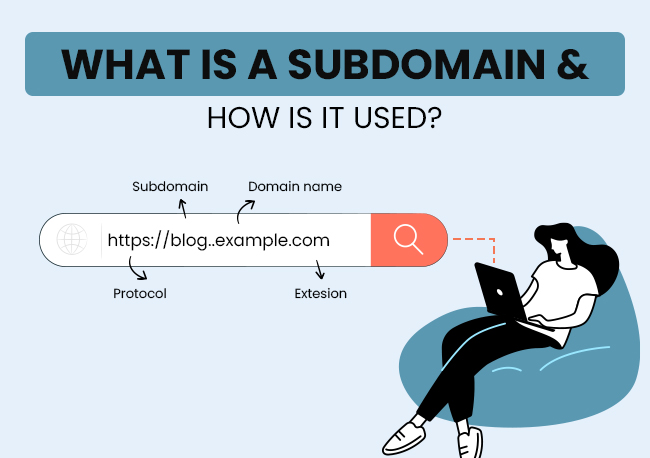What is a Subdomain?
The subdomain is part of the additional information added at the beginning of the website domain name. Allows websites to classify and organize content for a specific activity – such as a blog or online store – from across your website.
A subdomain allows you to split sections of your site-wide enough to authorize their dedicated section without having to deal with the hassle of setting up a new domain with a new domain or confusing visitors with a completely different domain.
With a subdomain, you create a unique website where you can use a different website theme in terms of its appearance, menus, and functionality. Because a domain and a subdomain function as two separate websites, they are also tracked separately. This allows the business to provide unique user information and more accurately track user data and statistics, which can be used to improve and enhance both the primary URL and subdomain.
For example – store.yourwebsite.com
In this example, ‘store’ is the subdomain, ‘your website’ is the main domain and ‘.com’ is the main domain (TLD). You can use any text as your subdomain, but you want to make sure, It is easy to write and remember.
Now, As you understand, What are subdomains in web hosting? Now, Let’s know about Wildcard Subdomains in short.
What is Wildcard Subdomain?
The Wildcard subdomain allows you to identify all sub-domains that are not in a specific folder in your account. It means that if you add different subdomains (not created in your cPanel) to your browser, they will all display the same content you uploaded to a folder set in the wildcard domain.
Also Read: Understanding Domain Names – A Complete Guide
Use Cases of Subdomain
The most widely used domain setting is to create a test version or platform for a website. Developers will usually check for new WordPress plugins and updates on the subdomain site before publishing them live online.
Another common use of a subdomain is to create an online eCommerce website. Usually, companies are looking for a different subdomain that will handle transactions because eCommerce sites often require a more complex setup.
We have also seen companies use subtitles for their mobile websites (m.yoursite.com), site-specific sites (uk.yoursite.com), and create website sections.
Other uses of the following domains are:
- Create different language versions of the website (en.yoursite.com).
- Create a mobile version of the website (m.yoursite.com).
- Set up a network of unrelated sites. For example, how to sign up for a WordPress.com account and create your blog in a subdomain (yourblog.wordpress.com).
These are a few reasons why you use a subdomain for your website.
Also Read: Top 13 Techniques To Find Creative Domain Names For Your Business.
What is a subdirectory?
The subdirectory is a type of sub-domain that uses folders to organize content on a website. The subdirectory is like a small folder and the words can be used interchangeably.
In the URL, the subdirectory comes after the root directory or domain name. For example, the root directory of a company is company.com. So, the URL below the list may be company.com/products. Or it may be as complex as company.com/products/pricing.
When it comes to subdirectories, think of a structure resembling a breeding doll. Each folder can be built into the other almost permanently. That means you can have a subfolder inside the subfolder until you have a pile, which is probably hundreds, of deeper layers.
Too many layers of subfolders can be a nightmare for SEO. The URL series gets long and confusing, user information is compromised with every click you take to get to the next piece of content, and search engine searchers will find it almost impossible to crawl your site to find new content and other SEO winnings you can do.
On the other hand, sub-folders can be good for SEO as they retain any backlinks obtained, domain authority, and page authority tied around the root domain. And if the site is easy to navigate, URLs are shorter and simpler, like company.com/careers, which means you can market specific web pages or predict pages with their URLs without confusing your audience.
Also Read: Should I Buy Multiple Domain Names And Extensions?
Difference Between Subdomain and Subdirectory
A subdomain separates your website so you can create certain types of content that are different from your root domain. On the other hand, the sub-directory is the way within your site. Subdirectories are the internal level of a domain.
Technically, a website can use both a subdomain and a subtitle structure. Sub-domains will usually have at least a few subfolders within them to organize the content, but not as many as the subdirectory. That is because there is a small variety of content covered in the sub-domain of the root domain with subfolders.
Therefore, it is important to understand what the main structure of your website will be. To determine this, let’s take a look at how sub-domains and sub-directory affect SEO.
Also: How Do You Transfer A Domain Name
Which Is Better: A Subdirectory or Subdomain?
Although this topic may be confusing, ultimately, the decision depends on the needs of your website. Sub-domains can provide structure to your site if you have a lot of different, but important content to share. The subtitle can be useful for small websites that do not have a variety of content. No matter what format you choose, you will want to stay informed of the best SEO practices to meet the goals of your website.
Also Read: Do Domain Extensions Impact SEO?
Are Subdomains Useful in SEO?
Using a subdomain enables you to organize your site as well as make the navigation easier for the user. They can easily find the relevant information without any hassle. The effectiveness in navigation by a subdomain can positively impact the SEO performance. Here are some ways that can happen:
1. Easy Navigation
A subdomain is essentially just an expansion of your main website. When you want to dive deep into details of a particular topic but don’t want it on the main website, you can use the subdomain to store the information in another additional web page associated with the subdomain.
This organization of information makes the user experience less hectic and more enjoyable, which favours positively in keyword ranking.
2. Keyword as Subdomain
Keywords are very important for a better SEO, by using high-traffic keywords which match with your topic, as the subdomain can yield high traffic and higher SEO rankings.
Also Read: How Many Keywords Can A Website Use For SEO in 2024?
3. Targeting International Market is Easier
As a subdomain is used to create specialized content, if that specialized content applies to a certain demographic, it can drive international users of certain countries and continents towards your website if you are operating internationally. This may result in higher SEO rankings in those countries.
4. Mobile friendly subdomains
Experts always suggest that there is much importance of mobile-friendly websites because Google prioritizes mobile-friendly websites over desktop exclusive sites. So, you can create a mobile-friendly interface by using subdomains. Which may favor SEO positively.
In short, using a subdomain enables you to fine-tune your site’s domain and improve user navigation. This helps users find the information they are looking for effectively, which can help in improving your SEO performance.
Also Read: What To Do When Your Domain Name Is Taken?
Frequently Asked Questions About Subdomains
Subdomains act like a smaller part of a website. It is worked by adding a prefix to the main domain name like “blog.abc.com” or “shop.abc.com.”
To create a subdomain for a website, go to your domain registrar’s website and check for the DNS settings. Add a new record with your desired subdomain name and point it to the IP address where your website is hosted.
Subdomains act as small sections of a website with its own unique address. They can be treated as separate sites with different content, even though they are part of the same main website.
Yes, subdomains are usually created for free. It acts like an extension of a main domain and is used to create separate websites or sections. However, hosting services may charge for certain advanced features or customization.
Yes, Subdomains have their own analytics and tracking systems that allow you to gather insights specifically for that subdomain, like visitor statistics and user behavior.
Final Point
The subdomains are part of the primary domain. Businesses use subdomains over a small business website for several reasons, but most often create a unique extension of their core site with direct performance for different audiences.
A subdomain can be a useful tool to help you organize your website effectively, and if used properly, it will not harm the SEO of your website. However, sub-domains can be better used if you want the content to be private and not on your public sites.




